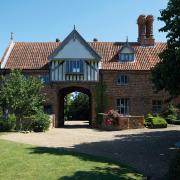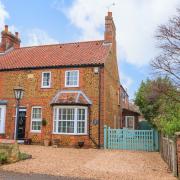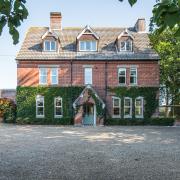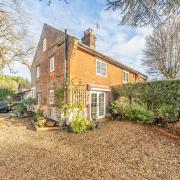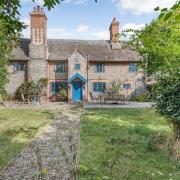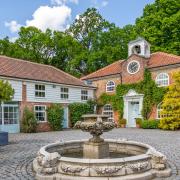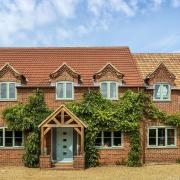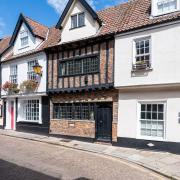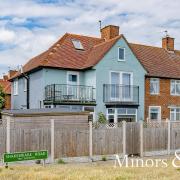The rose-red villages centred on Sandringham are alive with wildlife, tradition and community, says Rowan Mantell

A is for Anmer and Norfolk’s most recent royal residence. In this tiny village, tucked into woodland a couple of miles from Sandringham Park, the Duke and Duchess of Cambridge are raising Prince George and Princess Charlotte, who can play in some of the loveliest countryside in their Great Grandma’s realm.
B is for birds which fill the wide skies. A cloud of finches explodes from the majestic beech-lined avenue between Anmer and the gates of Sandringham. Pheasants bob from hedgerows. Visiting wildfowl flock in from the Arctic in winter, Africa in summer.

C is for carrstone, the warm red stone which makes the houses, barns, field boundaries and estate walls of this area look as if they have soaked up the rays of the nearby west coast sunsets. And carrstone, layered with chalk, gives the cliffs at Hunstanton their famous stripes.
D is for Dersingham, just a mile from the royal estate and brimming with both history and new projects for the future. This month there are village sports and a vintage and handmade fair; soon there could be a whole new community hall.

E is for estate. The Sandringham estate employs more than 200 people, including farmers, foresters and gardeners, plus staff to look after thousands of visitors – and the Royal Family too.
F is for Flitcham, where an ancient church stands over the village St Felix visited in the seventh century. There is a charming carrstone primary school, a fine old community centre complete with (disused) carrstone rifle range, a bowling green and flowers rising from pots and baskets, where floury loaves once rose in the former bakery.
G is for George. As well as the young prince, his great great grandfather, George V, and great great great grandfather, George VI, loved Sandringham too.
H is for Hillington, where grand gatehouses still stand to hint at the splendour of the demolished hall.
I is for Ingoldisthorpe, a Viking name for a pretty village, with a primary school which so values its surroundings that once a week, come rain or shine, the entire school goes outside together to continue learning.
K is for kings. The estate was bought by Queen Victoria, for her son, the future King Edward VII, and was subsequently owned by her grandson, King George V, who called Sandringham, “The place I love better than anywhere else in the world,” and her great grandson, King George VI, who wrote: “I have always been happy here and I love the place.”
L is for local charities – which have received more than £500,000 from the Sandringham Flower Show Committee since 1977.
M is for Mary Magdalene church, Sandringham. It is one of the finest of all the region’s carrstone buildings and where the Royal Family attend church every Christmas morning. Babies baptised here include the future King George VI in 1896, Diana Princess of Wales in 1961 and Princess Charlotte in 2015.
N is for nature. The Dersingham Bog National Nature Reserve is home to rare plants, including bog asphodel, round-leaved sundew, cranberry and white-beaked sedge in its wet peatland, and woodland glades attract birds such as the redpoll, crossbill, long-eared owl and sparrowhawk. It is open all year – but the very best time to see it is right now, in July and August.
O is for open day. For the past 21 summers, archaeologists have been excavating around the village of Sedgeford. The Sedgeford Historical and Archaeological Research Project has uncovered fascinating details about the way Sedgeford people have lived for more than 1,000 years. This year’s projects are looking at Anglo Saxon, medieval and First World War Sedgeford. The annual open day is on Sunday, August 7.
P is for pigeons. The Queen’s racing pigeons reside in the Royal Loft in Wolferton. The hobby has passed down from monarch to monarch and Her Majesty is a knowledgeable owner who visits regularly.
Q is for the Queen, who spends every Christmas at Sandringham, surrounded by her family, and is considered a fellow local by many of the people living nearby.
R is for royalty. Much of the charm of the area comes from the conservation and preservation projects set up by the Royal Family.
S is for Snettisham, a lively village of old cottages clustered close together in the historic centre, bungalows strung like bunting along the coast road, a stunning church capped by a spire, unusual in this region of sturdy towers. And, utterly unique, the scores of gold torques, made more than 2,000 years ago, unearthed here and now known worldwide as the Snettisham Hoard.
T is for trains. Once kings and tsars, empresses and princesses alighted for Sandringham at Wolferton Station. The railway lines are no more, but the buildings have been beautifully restored to something reminiscent of their royal heyday.
U is for undulating. This part of Norfolk is definitely not flat. Whichever level, and lovely, land Noel Coward was thinking of, it was not this rolling region of lanes and streams meandering from heath to coast.
V is for villages, which are the heart of the Sandringham area. And for visitors, who come to catch a glimpse of the royals and stay to revel in their rural idyll.
W is for West Newton, where the Queen is a member of the village Women’s Institute.
X is for Xmas trees, sold from the Sandringham Estate every year.
Y is for yearly. The flow of the seasons is obvious around the Royal Estate villages, with their reliance on farming and tourism. Every year there are fetes and sports days, a series of traditional royal visits, and the highlights of Christmas and the Sandringham Flower Show.
Z is for Zoo, which is a collection of animals. The collections of animals in the Sandringham area might not include lions and tigers – but there are deer, goats, sheep, pigs, guinea pigs and tortoises at Snettisham Park, horses at the Royal Stud, and avocets and painted lady butterflies fly over Snettisham RSPB reserve.








